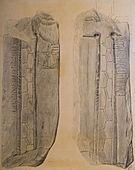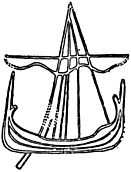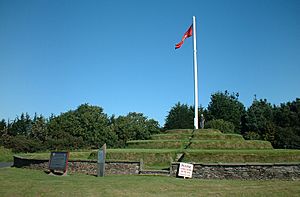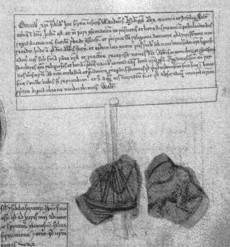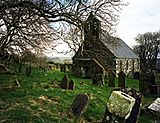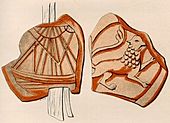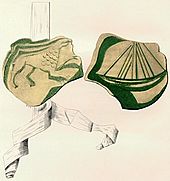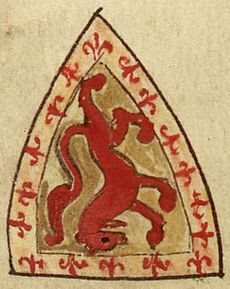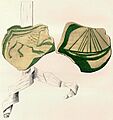Haraldr Óláfsson facts for kids
Quick facts for kids Haraldr Óláfsson |
|
|---|---|

Haraldr's name and title as it appears on folio 115r of AM 45 fol (Codex Frisianus): "Haralldi Suðreyinnga konvngi".
|
|
| King of Mann and the Isles | |
| Reign | 1237–1248 |
| Predecessor | Óláfr Guðrøðarson |
| Successor | Rǫgnvaldr Óláfsson |
| Born | 1222 or 1223 |
| Died | 1248 Sumburgh Roost |
| Spouse | Cecilía Hákonardóttir |
| House | Crovan dynasty |
| Father | Óláfr Guðrøðarson |
Haraldr Óláfsson (born 1223 or 1224; died 1248) was a king who ruled the Kingdom of Mann and the Isles in the 1200s. He was part of the Crovan dynasty, a powerful family that ruled these islands. Haraldr was one of the sons of Óláfr Guðrøðarson, who was also King of the Isles. We are not sure who his mother was.
When his father died in 1237, Haraldr became king at just fourteen years old. He ruled for about ten years. Early in his reign, Haraldr faced a challenge from a relative. After this, he was forced to leave Mann by representatives of Hákon Hákonarson, King of Norway. This likely happened because Haraldr had refused to show his loyalty to King Hákon.
Haraldr could not defeat Hákon's supporters in the Isles. So, he eventually went to Norway and submitted to Hákon. He stayed there for about two or three years before being allowed to return and rule the Isles again. Unlike earlier kings, Haraldr seemed to prefer the title "King of Mann and the Isles."
Haraldr ruled during a time when the English, Norwegian, and Scottish kings all wanted control over the Isles. Like his father, Haraldr was made a knight by Henry III, King of England. This brought him closer to England. However, in late 1247, Haraldr went back to Norway. He married Hákon's daughter, Cecilía, which strengthened his ties to Norway.
In the autumn of 1248, Haraldr and his new wife were sailing back to the Isles. Their ship was lost at sea south of Shetland in a dangerous area called Sumburgh Roost. News of Haraldr's death reached Mann by spring 1249. His younger brother, Rǫgnvaldr, then became king. Haraldr was a popular and skilled king. His sudden death led to more family conflicts within the Crovan dynasty. This chaos also helped Alexander II, King of Scotland, invade Argyll and almost take over the Hebrides.
Contents
Who Was Haraldr?
Haraldr was the son of Óláfr Guðrøðarson, King of the Isles. He was a member of the Crovan dynasty, a family that ruled the islands for a long time. We are not completely sure who Haraldr's mother was. His father, Óláfr, had two wives. One was named Lauon, who was likely from a powerful family called Clann Somhairle. His second wife was Cairistíona.
The Chronicle of Mann, a historical record, says that Óláfr died in 1237. It also states that Haraldr was fourteen years old at that time. This means Haraldr was born around 1222 or 1223. This was about the time his father married his second wife. So, either woman could have been Haraldr's mother.
Haraldr's reign happened during a break in a long and fierce fight. This fight was between two different parts of the Crovan dynasty for control of the kingdom. This family struggle started in the late 1100s. It began after Haraldr's grandfather, Guðrøðr Óláfsson, King of Dublin and the Isles, died.
| A simplified family tree of the Crovan dynasty, showing how Haraldr was related to other family members of his time. | ||||||||||||||||||||||||||||||||||||||||||||||||||||||||||||||||||||||||||||||||||||||||||||||||||||||||||||||||||||||||||||||||||||||||||||||||||||||||||||||||||||||||||||||||||||||||||||||||||||||||||||||||||||||||||||||||||||||
|---|---|---|---|---|---|---|---|---|---|---|---|---|---|---|---|---|---|---|---|---|---|---|---|---|---|---|---|---|---|---|---|---|---|---|---|---|---|---|---|---|---|---|---|---|---|---|---|---|---|---|---|---|---|---|---|---|---|---|---|---|---|---|---|---|---|---|---|---|---|---|---|---|---|---|---|---|---|---|---|---|---|---|---|---|---|---|---|---|---|---|---|---|---|---|---|---|---|---|---|---|---|---|---|---|---|---|---|---|---|---|---|---|---|---|---|---|---|---|---|---|---|---|---|---|---|---|---|---|---|---|---|---|---|---|---|---|---|---|---|---|---|---|---|---|---|---|---|---|---|---|---|---|---|---|---|---|---|---|---|---|---|---|---|---|---|---|---|---|---|---|---|---|---|---|---|---|---|---|---|---|---|---|---|---|---|---|---|---|---|---|---|---|---|---|---|---|---|---|---|---|---|---|---|---|---|---|---|---|---|---|---|---|---|---|---|---|---|---|---|---|---|---|---|---|---|---|---|---|---|---|
|
||||||||||||||||||||||||||||||||||||||||||||||||||||||||||||||||||||||||||||||||||||||||||||||||||||||||||||||||||||||||||||||||||||||||||||||||||||||||||||||||||||||||||||||||||||||||||||||||||||||||||||||||||||||||||||||||||||||
Haraldr also ruled when three powerful crowns wanted control over the Isles. The Isles included the Hebrides and the Isle of Man. In the Norse world, these were called Suðreyjar, meaning "Southern Islands." This name came from their location south of Norway.
Since the early 1100s, the Norwegian Crown claimed to have the most power in the Isles. During Haraldr's time, Hákon Hákonarson, King of Norway, was a very strong ruler. He worked hard to strengthen his power in distant Norse lands like the Isles. At the same time, the Scottish Crown, led by Alexander II, King of Scotland, was gaining control over Scotland's western coast. He wanted to expand Scottish power into the Isles. Meanwhile, Henry III, King of England, also had an interest in the Isles. He tried to bring the Crovan dynasty closer to the English Crown.
Becoming King and Showing Loyalty
After his father died, Haraldr became king. Unlike his father, who ruled a divided kingdom and faced many family conflicts, Haraldr seemed to rule a united kingdom. His young age when he became king, and the fact that he had a possible rival, suggest that his father had chosen him as the next ruler.
Soon after becoming king, the Chronicle of Mann says Haraldr sailed to the Hebrides. He left a relative named Lochlann in charge of Mann. Lochlann's time on the island led to trouble. When Haraldr returned the next spring, the chronicle says Lochlann fled to Wales. He took his foster-son, Guðrøðr Óláfsson, with him. The chronicle claims their ship was lost, and Lochlann and his foster-son died. We don't know why Lochlann had to flee. Perhaps he feared the king because a friend of Haraldr's had been killed in an uprising Lochlann put down. It's also possible Lochlann led a group against Haraldr.
Later in 1238, the chronicle tells us that King Hákon's representatives forced Haraldr off Mann. This happened because Haraldr had refused to show his loyalty, or homage, to Hákon in Norway. Hákon's envoys, Gospatric and Giolla Críost mac Muircheartaigh, took control of the island. They also collected taxes that were owed to the Norwegian king. By sending these men, who had no family claim to the kingdom, Hákon ignored other possible rulers.
Haraldr tried several times to remove Hákon's representatives. He invaded Mann from the Hebrides, but he was not successful. The chronicle says he finally went to Norway to submit to Hákon. After staying in Scandinavia for about two or three years, Haraldr and Hákon made peace. Hákon then gave Haraldr back his kingship. The Norwegian king clearly defined the borders of Haraldr's kingdom. It included the islands that Haraldr's father, uncle, and grandfather had ruled. This meant Hákon purposely excluded the islands ruled by the Clann Somhairle family. He also limited Haraldr from becoming too close to Scottish interests. When Haraldr returned to the Isles, the Manx people were very happy. The chronicle says he then ruled peacefully and was friends with both the English and Scottish Crowns.
Royal Documents and Honors
Haraldr's grandfather was the first in the Crovan dynasty known to use a seal. A seal was like a stamp used to prove a document was real. None of the original seals from the Crovan dynasty have survived. However, people in the 1500s and 1600s drew pictures of them.
For Haraldr, an old historian named Christopher Hatton copied two of Haraldr's charters (official documents). He also drew pictures of the seals on them. By Hatton's time, the seals were in bad condition. But it is clear they had a lion on one side and a clinker-built galley (a type of ship) with sails on the other. Sadly, these charters and seals were destroyed in a fire in 1731.
Seals on documents not only proved they were real but also showed their importance. For example, when King Hákon officially made Magnús Óláfsson, King of Mann and the Isles, Haraldr's younger brother, king, the Chronicle of Mann says Hákon did it "by the protection of his seal." For the kings of the Crovan dynasty, whose military power came from their armed ships, the symbol of a ship on their seals showed their strength in the Isles.
One of Haraldr's charters with a seal was a gift to the monks of Furness Abbey. It gave them rights to mine on Mann, use a storage place, and be free from taxes. This document is the earliest proof of mining on the island. Haraldr also promised to protect the abbey's ships and goods. His friendly actions with the English abbey were different from his father's. His father had been warned by the English king not to harm the monks.
In another document, Haraldr confirmed a gift his father had made. This gift was of land and the churches of St Ninian and St Runius (both in the Manx parish of Marown) to Whithorn Priory in Galloway. Out of twenty royal charters known from the Crovan dynasty, only three are from Haraldr's time.
Like his father and his brother Magnús, Haraldr was made a knight by King Henry III of England. The chronicle says this happened in 1247. It adds that Haraldr returned home with "much honour, and great gifts." However, English records show it happened earlier, in 1246. A letter from the English king on January 9, 1246, gave Haraldr safe travel through England until May 27, 1246. Another historical record says Henry confirmed Haraldr's knighthood on Easter day that year.
The kings of the Crovan dynasty used different titles. Haraldr's father seemed to prefer "rex insularum" (King of the Isles). Haraldr and Magnús seemed to prefer "rex mannie et insularum" (King of Mann and the Isles). These titles are similar to the Gaelic title "rí Innsi Gall" (King of the islands of the foreigners). This title likely referred to Mann and the Hebrides. Other sources also called Haraldr similar names. For example, the Icelandic annals called him "Svðréyiakonvngs" (King of the Hebrides).
A Royal Marriage
In the autumn of 1247, Haraldr traveled to Norway again. This is known from the Chronicle of Mann and the Hákonar saga Hákonarsonar. Haraldr went from Oslo to Bergen. There, King Hákon gave his widowed daughter, Cecilía, in marriage to Haraldr. Cecilía was one of Hákon's children born outside of marriage.
King Hákon worked hard to strengthen his large Norwegian kingdom. By giving Cecilía in marriage to Haraldr, he brought the two kingdoms closer than ever. The writers of the chronicle clearly thought this marriage made Haraldr more important than earlier kings. They wrote that Hákon said he would hold his new son-in-law "in great glory and exalt the throne of his kingdom above all who ruled before him in the Isles."
While Haraldr was still in Norway, the saga says two important members of the Clann Somhairle family arrived at Hákon's court. These were Eóghan Mac Dubhghaill and Dubhghall mac Ruaidhrí. Both wanted to be king of the Isles. 1247 was also the year Hákon was crowned king. It's possible Eóghan and Dubhghall came because Norway was reasserting its power.
However, there might have been other reasons. In 1247, a key member of Clann Somhairle was killed fighting the English in Ireland. Haraldr had been knighted by King Henry the year before. This might have meant he showed loyalty to Henry. It's possible Hákon then recognized the Clann Somhairle leader as king of the Isles in response to Haraldr's ties with England. An alliance with a ruler of the Isles would have helped Henry's wars in Ireland. Haraldr's marriage to Cecilía might have been Hákon's way of bringing Haraldr back to his side.
Haraldr's Death and What Happened Next
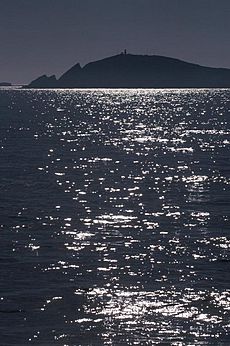
In 1248, Haraldr and Cecilía drowned while sailing from Norway to the Isles. This is recorded in the Chronicle of Mann, Hákonar saga Hákonarsonar, and the Icelandic annals. The Chronicle of Mann says Haraldr's death was "a cause of grief to all who had known him." The saga says his death was the "greatest harm and ill-luck" for the Islesmen. They "lost so suddenly such a prince, when his voyage to Norway had been so lucky."
Since the ship's wreckage washed ashore from the south, the saga says the ship was thought to have been lost south of Shetland. This happened in Dynröst, a dangerous tidal race now known as Sumburgh Roost or Da Roost. It lies between Sumburgh Head and Fair Isle. Among those who drowned was Laurence, a church leader from Mann. He had recently been chosen as the Bishop of the Isles.
Haraldr's death led to the final stage of family conflict within his dynasty. News of Haraldr and Cecilía's death probably did not reach Mann until spring 1249. According to the chronicle, Haraldr's younger brother, Rǫgnvaldr, became king on May 6, 1249. But he was killed on May 30 by a man who seemed to be working with Haraldr and Rǫgnvaldr's cousin, Haraldr Guðrøðarson.
With Rǫgnvaldr gone, Haraldr Guðrøðarson took the throne. He replaced Haraldr's supporters with his own. The chronicle says one of Haraldr Guðrøðarson's victims was a chieftain named "Dofnaldus." This man was highly respected by Haraldr but was imprisoned by Haraldr Guðrøðarson. We are not sure who this man was. He might be Domhnall, the ancestor of Clann Domhnaill. If so, and if Haraldr's mother was from Clann Somhairle, Dofnaldus would have been a close relative of Haraldr. Haraldr seemed to rely on support from the Hebrides rather than Mann during his reign. For example, the chronicle mentions three sons of a man named Niall who supported Haraldr early on.
The shipwreck that killed Haraldr and Cecilía showed how hard it was for the Norwegian Crown to control its distant lands across the sea. This disaster not only took away a skilled king from the Islesmen but also cost the Norwegian Crown a strong ally in the region. When King Hákon heard about the tragedy, he quickly sent Eóghan to temporarily rule the Isles for him.
However, Eóghan was loyal to Norway in the Isles, but he was also an important Scottish noble on the mainland. For several years, the Scottish Crown had tried to take the Hebrides from Norway. They also wanted to expand their power in Argyll. The worsening relationship between Eóghan and Alexander, along with Haraldr's death, the family conflicts over who would be king, and Eóghan taking royal power for Hákon, all likely led to a large Scottish invasion into Argyll that year.
Alexander demanded that Eóghan stop being loyal to Hákon. He also ordered Eóghan to hand over certain castles on the mainland and islands. Eóghan then seemed to retreat to the northern Hebrides. This crisis only ended with the Scottish king's sudden death in July. According to Hákonar saga Hákonarsonar, Alexander had made it clear he would not turn back until he controlled the western Norwegian lands he wanted. Within about twenty years, Alexander's son, Alexander III, would achieve these goals. This led to the end of Norwegian rule in the Isles and the end of the Crovan dynasty itself.
Haraldr's Family Tree
| Ancestors of Haraldr Óláfsson | |||||||||||||||||||||||||||||||||||||||||||||||||||||||||||||||||||||||||||||||||||||||||||||||||||||||||||||||||||||||||||||||||||||||||||||||||||||||||||||||||||||||||||||||||||||||||||||||||||||||||||||||||||||||||||||||||||||||||||||||||||||||||||||||||||||||||||||||||||||||||||||||||||||||||||||||||||||||||||
|---|---|---|---|---|---|---|---|---|---|---|---|---|---|---|---|---|---|---|---|---|---|---|---|---|---|---|---|---|---|---|---|---|---|---|---|---|---|---|---|---|---|---|---|---|---|---|---|---|---|---|---|---|---|---|---|---|---|---|---|---|---|---|---|---|---|---|---|---|---|---|---|---|---|---|---|---|---|---|---|---|---|---|---|---|---|---|---|---|---|---|---|---|---|---|---|---|---|---|---|---|---|---|---|---|---|---|---|---|---|---|---|---|---|---|---|---|---|---|---|---|---|---|---|---|---|---|---|---|---|---|---|---|---|---|---|---|---|---|---|---|---|---|---|---|---|---|---|---|---|---|---|---|---|---|---|---|---|---|---|---|---|---|---|---|---|---|---|---|---|---|---|---|---|---|---|---|---|---|---|---|---|---|---|---|---|---|---|---|---|---|---|---|---|---|---|---|---|---|---|---|---|---|---|---|---|---|---|---|---|---|---|---|---|---|---|---|---|---|---|---|---|---|---|---|---|---|---|---|---|---|---|---|---|---|---|---|---|---|---|---|---|---|---|---|---|---|---|---|---|---|---|---|---|---|---|---|---|---|---|---|---|---|---|---|---|---|---|---|---|---|---|---|---|---|---|---|---|---|---|---|---|---|---|---|---|---|---|---|---|---|---|---|---|---|---|---|---|---|---|---|---|---|---|---|---|---|---|---|---|---|---|---|---|---|---|
|
|||||||||||||||||||||||||||||||||||||||||||||||||||||||||||||||||||||||||||||||||||||||||||||||||||||||||||||||||||||||||||||||||||||||||||||||||||||||||||||||||||||||||||||||||||||||||||||||||||||||||||||||||||||||||||||||||||||||||||||||||||||||||||||||||||||||||||||||||||||||||||||||||||||||||||||||||||||||||||
Images for kids
-
Maughold IV (image a; detail, image b), a Manx runestone displaying a contemporary sailing vessel. The power of the kings of the Isles laid in their armed galley-fleets.
-
Maughold IV (image a; detail, image b), a Manx runestone displaying a contemporary sailing vessel. The power of the kings of the Isles laid in their armed galley-fleets.
-
Tynwald Hill, near St John's may have been a national assembly site of the Kingdom of the Isles. It may well have been the place where the Islesmen publicly inaugurated their kings, proclaimed new laws, and resolved disputes. Be that as it may, much of the visible site dates only to the eighteenth-, nineteenth-, and twentieth century.
-
Coat of arms of Hákon Hákonarson as depicted on folio 216v of Cambridge Corpus Christi College Parker Library 16II (Chronica majora).
-
Sumburgh Head. Haraldr is said to have drowned nearby in Sumburgh Roost, a dangerous tidal race called Dynröst by Hákonar saga Hákonarsonar, now known to Shetlanders as Da Roost.
-
Nineteenth-century representations of seventeenth-century illustrations of Haraldr's now non-existent seals.
-
Nineteenth-century representations of seventeenth-century illustrations of Haraldr's now non-existent seals.
-
Coat of arms of Alexander as it appears on folio 146v of British Library Royal 14 C VII (Historia Anglorum). The inverted shield represents the king's death in 1249.



